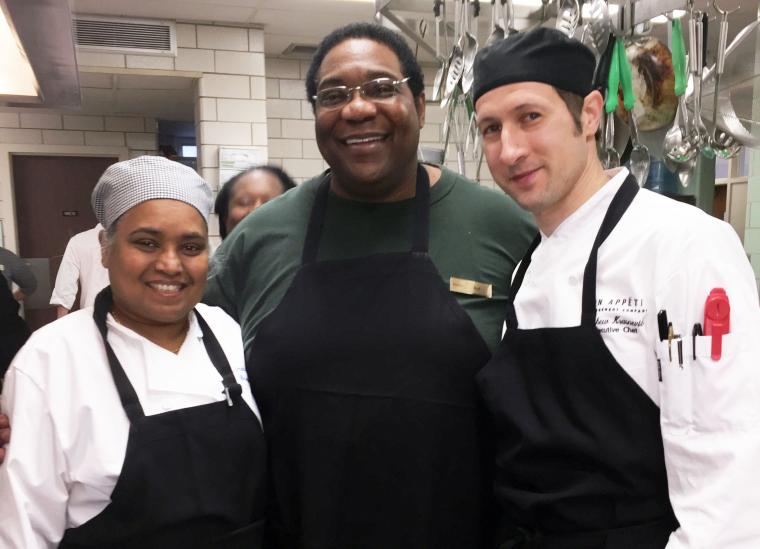Cooking for a Community
April 10, 2017
Justine Goode

Chef Vimala Rajendron (left) taught CDS staff members how to prepare traditional Indian dishes such as chicken tikka marsala, pork vindaloo, cabbage bhaji, and chana marsala.
Photo credit: Wayne Wood
On March 23 and 24, the staff of Campus Dining Services (CDS) attended intensive Indian cuisine training sessions with chef Vimala Rajendron, a native of Mumbai, India and owner of Vimala’s Curryblossom Cafe in Chapel Hill, North Carolina. Over the course of two eight-hour sessions, Rajendron taught campus chefs how to prepare such dishes as chicken tikka marsala, pork vindaloo, cabbage bhaji, and chana marsala, as well as her renowned cardamom brownies. A self-described “accidental chef,” Rajendron wove anecdotes from her life and career throughout the two-day training.
She began by reading an award-winning poem written by her son, Rajeev Rajendron, which highlights the heritage, sense of community, and “alchemy” inherent to their family’s cooking. With these themes in mind, Rajendron helped CDS staff to prep dishes and create spice mixes. “She opened my eyes to spices like black cardamom and black salt, which create these amazing flavor profiles,” says Matt Krasnevich, a chef and manager of Stevenson Dining Hall. Krasnevich also noted that Rajendron’s approach to Indian cooking is not wholly traditional, and instead emphasizes local and organic ingredients—for instance, she uses beets to flavor and color tandoori chicken, sweetens her dishes with fruit instead of refined sugar, and created a “green” pork vindaloo with serrano peppers, apples, and ginger. “Vimala takes recipes and puts her own spin on it,” Krasnevich says.
Rajendron also included a classroom component in the training, where she discussed the differences between North and South Indian cuisines, and helped chefs analyze the flavor profiles of each region. She also described the influence of British colonization on the Western perception of Indian cuisine (for example, the word “curry” simply means “sauce,” and only after the British creation of curry powder did the word become associated with a specific flavoring).
The recipes from Rajendron’s training are already being implemented in CDS and can be found in the Classic Comforts and Vegetarian sections at Stevenson. Along with hot dishes and desserts, CDS will soon serve chai tea, the first specially prepared warm drink to appear in the dining halls.
Wayne Wood, general manager of CDS, notes that Rajendron’s mentoring mirrors a past partnership with Vel Scott, a local food expert and Cleveland business owner who brought healthy soul food to Oberlin’s campus last August. “The great thing about guest chefs is learning different techniques,” says Wood. “Vel Scott emphasizes cutting down on sodium and sugar. Vimala highlights flavor profiles, spice blends, and staying true to the ingredients.”
According to Wood, the trainings exemplify a desire on the part of the Dining Committee to represent more types of cuisines in Oberlin’s dining halls. The Dining Committee, an organization led by students and staff members that meets on a weekly basis, was recently revived after several semesters of inactivity. In its first semester back, the organization has hosted Michael Twitty, a food writer and creator of the blog Afroculinaria, Rajendron, and is planning a forthcoming workshop with pastry chef Jim Dodge.
Both Krasnevich and Wood are optimistic about the future of CDS now that the Dining Committee has been reinstated. “With a weekly committee back in action, we can solve a problem in a more timely fashion,” says Krasnevich. Agrees Wood, “Times have changed. We’re updating, and we need the campus to let us know what they would like to see us doing.”
You may also like…
Josh Nolan Named Vice President, General Counsel, and Secretary at Oberlin
Distinguished attorney brings extensive experience in higher education law.
Learning by Teaching: Oberlin Students Share Global Music with Young Learners
College and Conservatory students in PACE 103 prepare local children for an immersive community concert at Oberlin.
Nuiko Wadden ’02 Joins Oberlin Conservatory Faculty as Assistant Professor of Harp
The versatile musician brings extensive opera, orchestral, and contemporary music experience to her role


